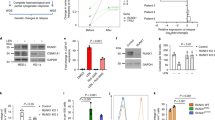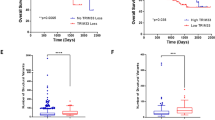Abstract
Allelic deletion of the RPS14 gene is a key effector of the hypoplastic anemia in patients with myelodysplastic syndrome (MDS) and chromosome 5q deletion (del(5q)). Disruption of ribosome integrity liberates free ribosomal proteins to bind to and trigger degradation of mouse double minute 2 protein (MDM2), with consequent p53 transactivation. Herein we show that p53 is overexpressed in erythroid precursors of primary bone marrow del(5q) MDS specimens accompanied by reduced cellular MDM2. More importantly, we show that lenalidomide (Len) acts to stabilize MDM2, thereby accelerating p53 degradation. Biochemical and molecular analyses showed that Len inhibits the haplodeficient protein phosphatase 2A catalytic domain alpha (PP2Acα) phosphatase resulting in hyperphosphorylation of inhibitory serine-166 and serine-186 residues on MDM2, and displaces binding of RPS14 to suppress MDM2 autoubiquitination whereas PP2Acα overexpression promotes drug resistance. Bone marrow specimens from del(5q) MDS patients resistant to Len overexpressed PP2Acα accompanied by restored accumulation of p53 in erythroid precursors. Our findings indicate that Len restores MDM2 functionality in the 5q- syndrome to overcome p53 activation in response to nucleolar stress, and therefore may warrant investigation in other disorders of ribosomal biogenesis.
This is a preview of subscription content, access via your institution
Access options
Subscribe to this journal
Receive 50 print issues and online access
$259.00 per year
only $5.18 per issue
Buy this article
- Purchase on Springer Link
- Instant access to full article PDF
Prices may be subject to local taxes which are calculated during checkout






Similar content being viewed by others
References
Nimer SD Myelodysplastic syndromes. Blood, 2008 111: 4841–4851.
Look AT Molecular Pathogenesis of MDS. Hematology Am Soc Hematol Educ Program, 2005. 156–160.
List A Lenalidomide--a transforming therapeutic agent in myelodysplastic syndromes. Clin Lymphoma Myeloma, 2009 9(Suppl 3): S302–S304.
Ebert BL Deletion 5q in myelodysplastic syndrome: a paradigm for the study of hemizygous deletions in cancer. Leukemia, 2009 23: 1252–1256.
Ebert BL, Pretz J, Bosco J, Chang CY, Tamayo P, Galili N et al. Identification of RPS14 as a 5q- syndrome gene by RNA interference screen. Nature, 2008 451: 335–339.
Lehmann S, O'Kelly J, Raynaud S, Funk SE, Sage EH, Koeffler HP Common deleted genes in the 5q- syndrome: thrombocytopenia and reduced erythroid colony formation in SPARC null mice. Leukemia, 2007 21: 1931–1936.
Joslin JM, Fernald AA, Tennant TR, Davis EM, Kogan SC, Anastasi J et al. Haploinsufficiency of EGR1, a candidate gene in the del(5q), leads to the development of myeloid disorders. Blood, 2007 110: 719–726.
Starczynowski DT, Kuchenbauer F, Argiropoulos B, Sung S, Morin R, Muranyi A et al. Identification of miR-145 and miR-146a as mediators of the 5q- syndrome phenotype. Nat Med, 2010 16: 49–58.
Lohrum MA, Ludwig RL, Kubbutat MH, Hanlon M, Vousden KH Regulation of HDM2 activity by the ribosomal protein L11. Cancer Cell, 2003 3: 577–587.
Zhang Y, Lu H Signaling to p53: ribosomal proteins find their way. Cancer Cell, 2009 16: 369–377.
Fumagalli S, Di Cara A, Neb-Gulati A, Natt F, Schwemberger S, Hall J et al. Absence of nucleolar disruption after impairment of 40S ribosome biogenesis reveals an rpL11-translation-dependent mechanism of p53 induction. Nat Cell Biol, 2009 11: 501–508.
Dutt S, Narla A, Lin K, Mullally A, Abayasekara N, Megerdichian C et al. Haploinsufficiency for ribosomal protein genes causes selective activation of p53 in human erythroid progenitor cells. Blood, 2011 117: 2567–2576.
Danilova N, Sakamoto KM, Lin S Ribosomal protein S19 deficiency in zebrafish leads to developmental abnormalities and defective erythropoiesis through activation of p53 protein family. Blood, 2008 112: 5228–5237.
Jones NC, Lynn ML, Gaudenz K, Sakai D, Aoto K, Rey JP et al. Prevention of the neurocristopathy Treacher Collins syndrome through inhibition of p53 function. Nat Med, 2008 14: 125–133.
McGowan KA, Li JZ, Park CY, Beaudry V, Tabor HK, Sabnis AJ et al. Ribosomal mutations cause p53-mediated dark skin and pleiotropic effects. Nat Genet, 2008 40: 963–970.
Barlow JL, Drynan LF, Hewett DR, Holmes LR, Lorenzo-Abalde S, Lane AL et al. A p53-dependent mechanism underlies macrocytic anemia in a mouse model of human 5q- syndrome. Nat Med, 2010 16: 59–66.
List A, Dewald G, Bennett J, Giagounidis A, Raza A, Feldman E et al. Lenalidomide in the myelodysplastic syndrome with chromosome 5q deletion. N Engl J Med, 2006 355: 1456–1465.
List A, Kurtin S, Roe DJ, Buresh A, Mahadevan D, Fuchs D et al. Efficacy of lenalidomide in myelodysplastic syndromes. N Engl J Med, 2005 352: 549–557.
Wei S, Chen X, Rocha K, Epling-Burnette PK, Djeu JY, Liu Q et al. A critical role for phosphatase haplodeficiency in the selective suppression of deletion 5q MDS by lenalidomide. Proc Natl Acad Sci USA, 2009 106: 12974–12979.
Ebert BL Molecular dissection of the 5q deletion in myelodysplastic syndrome. Semin Oncol, 2011 38: 621–626.
Liu G, Terzian T, Xiong S, Van Pelt CS, Audiffred A, Box NF et al. The p53-Mdm2 network in progenitor cell expansion during mouse postnatal development. J Pathol, 2007 213: 360–368.
Gandhi AK, Kang J, Naziruddin S, Parton A, Schafer PH, Stirling DI Lenalidomide inhibits proliferation of Namalwa CSN.70 cells and interferes with Gab1 phosphorylation and adaptor protein complex assembly. Leuk Res, 2006 30: 849–858.
Kruse JP, Gu W Modes of p53 regulation. Cell, 2009 137: 609–622.
Harris SL, Levine AJ The p53 pathway: positive and negative feedback loops. Oncogene, 2005 24: 2899–2908.
Westermarck J, Hahn WC Multiple pathways regulated by the tumor suppressor PP2A in transformation. Trends Mol Med, 2008 14: 152–160.
Mi J, Bolesta E, Brautigan DL, Larner JM PP2A regulates ionizing radiation-induced apoptosis through Ser46 phosphorylation of p53. Mol Cancer Ther, 2009 8: 135–140.
Meek DW, Hupp TR The regulation of MDM2 by multisite phosphorylation--opportunities for molecular-based intervention to target tumours? Semin Cancer Biol, 2009 20: 19–28.
Okamoto K, Li H, Jensen MR, Zhang T, Taya Y, Thorgeirsson SS et al. Cyclin G recruits PP2A to dephosphorylate Mdm2. Mol Cell, 2002 9: 761–771.
Zhou BP, Liao Y, Xia W, Zou Y, Spohn B, Hung MC HER-2/neu induces p53 ubiquitination via Akt-mediated MDM2 phosphorylation. Nat Cell Biol, 2001 3: 973–982.
Meek DW, Knippschild U Posttranslational modification of MDM2. Mol Cancer Res, 2003 1: 1017–1026.
Fang S, Jensen JP, Ludwig RL, Vousden KH, Weissman AM Mdm2 is a RING finger-dependent ubiquitin protein ligase for itself and p53. J Biol Chem, 2000 275: 8945–8951.
Honda R, Yasuda H Activity of MDM2, a ubiquitin ligase, toward p53 or itself is dependent on the RING finger domain of the ligase. Oncogene, 2000 19: 1473–1476.
O'Connor PM, Jackman J, Jondle D, Bhatia K, Magrath I, Kohn KW Role of the p53 tumor suppressor gene in cell cycle arrest and radiosensitivity of Burkitt's lymphoma cell lines. Cancer Res, 1993 53: 4776–4780.
Ginzinger DG, Godfrey TE, Nigro J, Moore DH, Suzuki S, Pallavicini MG et al. Measurement of DNA copy number at microsatellite loci using quantitative PCR analysis. Cancer Res, 2000 60: 5405–5409.
Dai MS, Shi D, Jin Y, Sun XX, Zhang Y, Grossman SR et al. Regulation of the MDM2-p53 pathway by ribosomal protein L11 involves a post-ubiquitination mechanism. J Biol Chem, 2006 281: 24304–24313.
Quarello P, Garelli E, Carando A, Brusco A, Calabrese R, Dufour C et al. Diamond-Blackfan anemia: genotype-phenotype correlations in Italian patients with RPL5 and RPL11 mutations. Haematologica, 2010 95: 206–213.
Ogawara Y, Kishishita S, Obata T, Isazawa Y, Suzuki T, Tanaka K et al. Akt enhances Mdm2-mediated ubiquitination and degradation of p53. J Biol Chem, 2002 277: 21843–21850.
Zhou BB, Elledge SJ The DNA damage response: putting checkpoints in perspective. Nature, 2000 408: 433–439.
Li HH, Li AG, Sheppard HM, Liu X Phosphorylation on Thr-55 by TAF1 mediates degradation of p53: a role for TAF1 in cell G1 progression. Mol Cell, 2004 13: 867–878.
Oda K, Arakawa H, Tanaka T, Matsuda K, Tanikawa C, Mori T et al. p53AIP1, a potential mediator of p53-dependent apoptosis, and its regulation by Ser-46-phosphorylated p53. Cell, 2000 102: 849–862.
Wade M, Wang YV, Wahl GM The p53 orchestra: Mdm2 and Mdmx set the tone. Trends Cell Biol, 2010 20: 299–309.
Volonte D, Caveolin-1 Galbiati F. cellular senescence and pulmonary emphysema. Aging (Albany NY), 2009 1: 831–835.
Li L, Ren CH, Tahir SA, Ren C, Thompson TC Caveolin-1 maintains activated Akt in prostate cancer cells through scaffolding domain binding site interactions with and inhibition of serine/threonine protein phosphatases PP1 and PP2A. Mol Cell Biol, 2003 23: 9389–9404.
Fresno Vara JA, Casado E, de Castro J, Cejas P, Belda-Iniesta C, Gonzalez-Baron M PI3K/Akt signalling pathway and cancer. Cancer Treat Rev, 2004 30: 193–204.
Jadersten M, Saft L, Smith A, Kulasekararaj A, Pomplun S, Gohring G et al. TP53 mutations in low-risk myelodysplastic syndromes with del(5q) predict disease progression. J Clin Oncol, 2011 29: 1971–1979.
Ito T, Ando H, Suzuki T, Ogura T, Hotta K, Imamura Y et al. Identification of a primary target of thalidomide teratogenicity. Science, 2010 327: 1345–1350.
Whelan JA, Russell NB, Whelan MA A method for the absolute quantification of cDNA using real-time PCR. J Immunol Methods, 2003 278: 261–269.
Yokobori T, Mimori K, Iwatsuki M, Ishii H, Onoyama I, Fukagawa T et al. p53-Altered FBXW7 expression determines poor prognosis in gastric cancer cases. Cancer Res, 2009 69: 3788–3794.
Acknowledgements
This work was supported by NIH Grants 1R01CA131076 and AI056213.
Author contributions: Drs S Wei and A List designed research and wrote the manuscript. Drs X Chen, H Wang, N Fortenbery, J Zhou, K McGraw, J Clark, G Caceres and L Zhang conducted the research, Drs D Billingsley, L Sokol, J Lancet, J Maciejewski and M Sekeres provided patient’s specimens and analysis of clinical information of patients. Dr R Komrokji performed the statistic analysis. Drs D Sallman, PK Burnette and J Djeu contributed for preparation of the manuscript.
Author information
Authors and Affiliations
Corresponding author
Ethics declarations
Competing interests
The authors declare no conflict of interest.
Additional information
Supplementary Information accompanies the paper on the Oncogene website
Supplementary information
Rights and permissions
About this article
Cite this article
Wei, S., Chen, X., McGraw, K. et al. Lenalidomide promotes p53 degradation by inhibiting MDM2 auto-ubiquitination in myelodysplastic syndrome with chromosome 5q deletion. Oncogene 32, 1110–1120 (2013). https://doi.org/10.1038/onc.2012.139
Received:
Revised:
Accepted:
Published:
Issue Date:
DOI: https://doi.org/10.1038/onc.2012.139
Keywords
This article is cited by
-
A calcium- and calpain-dependent pathway determines the response to lenalidomide in myelodysplastic syndromes
Nature Medicine (2016)
-
The relationship of TP53 R72P polymorphism to disease outcome and TP53 mutation in myelodysplastic syndromes
Blood Cancer Journal (2015)
-
Myelodysplastic syndromes with 5q deletion: pathophysiology and role of lenalidomide
Annals of Hematology (2014)
-
Lenalidomide as a disease-modifying agent in patients with del(5q) myelodysplastic syndromes: linking mechanism of action to clinical outcomes
Annals of Hematology (2014)
-
A G polymorphism in the CRBN gene acts as a biomarker of response to treatment with lenalidomide in low/int-1 risk MDS without del(5q)
Leukemia (2013)



